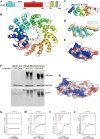Crystal structure of a TALE protein reveals an extended N-terminal DNA binding region
- PMID: 23147789
- PMCID: PMC3515758
- DOI: 10.1038/cr.2012.156
Crystal structure of a TALE protein reveals an extended N-terminal DNA binding region
Figures

Similar articles
-
Crystal Structure of Xanthomonas AvrRxo1-ORF1, a Type III Effector with a Polynucleotide Kinase Domain, and Its Interactor AvrRxo1-ORF2.Structure. 2015 Oct 6;23(10):1900-1909. doi: 10.1016/j.str.2015.06.030. Epub 2015 Sep 3. Structure. 2015. PMID: 26344722
-
Crystal structure of the C-terminal domain of a flagellar hook-capping protein from Xanthomonas campestris.J Mol Biol. 2008 Aug 1;381(1):189-99. doi: 10.1016/j.jmb.2008.05.083. Epub 2008 Jun 7. J Mol Biol. 2008. PMID: 18599076
-
Crystal structure of UbiX, an aromatic acid decarboxylase from the psychrophilic bacterium Colwellia psychrerythraea that undergoes FMN-induced conformational changes.Sci Rep. 2015 Feb 3;5:8196. doi: 10.1038/srep08196. Sci Rep. 2015. PMID: 25645665 Free PMC article.
-
Crystal structure of the C-terminal domain of the Salmonella type III secretion system export apparatus protein InvA.Protein Sci. 2010 May;19(5):1091-6. doi: 10.1002/pro.382. Protein Sci. 2010. PMID: 20306492 Free PMC article.
-
Transcription activator-like effectors: a toolkit for synthetic biology.ACS Synth Biol. 2014 Oct 17;3(10):708-16. doi: 10.1021/sb400137b. Epub 2014 Feb 13. ACS Synth Biol. 2014. PMID: 24933470 Free PMC article. Review.
Cited by
-
TALE proteins search DNA using a rotationally decoupled mechanism.Nat Chem Biol. 2016 Oct;12(10):831-7. doi: 10.1038/nchembio.2152. Epub 2016 Aug 15. Nat Chem Biol. 2016. PMID: 27526029
-
A single promoter-TALE system for tissue-specific and tuneable expression of multiple genes in rice.Plant Biotechnol J. 2022 Sep;20(9):1786-1806. doi: 10.1111/pbi.13864. Epub 2022 Jun 24. Plant Biotechnol J. 2022. PMID: 35639605 Free PMC article.
-
Selective recognition of N4-methylcytosine in DNA by engineered transcription-activator-like effectors.Philos Trans R Soc Lond B Biol Sci. 2018 Jun 5;373(1748):20170078. doi: 10.1098/rstb.2017.0078. Philos Trans R Soc Lond B Biol Sci. 2018. PMID: 29685980 Free PMC article.
-
Dissection of TALE-dependent gene activation reveals that they induce transcription cooperatively and in both orientations.PLoS One. 2017 Mar 16;12(3):e0173580. doi: 10.1371/journal.pone.0173580. eCollection 2017. PLoS One. 2017. PMID: 28301511 Free PMC article.
-
TALE-Like Effectors Are an Ancestral Feature of the Ralstonia solanacearum Species Complex and Converge in DNA Targeting Specificity.Front Plant Sci. 2016 Aug 17;7:1225. doi: 10.3389/fpls.2016.01225. eCollection 2016. Front Plant Sci. 2016. PMID: 27582755 Free PMC article.
References
-
- Boch J, Bonas U. Xanthomonas AvrBs3 family-type III effectors: discovery and function. Annu Rev Phytopathol. 2010;48:419–436. - PubMed
-
- Bogdanove AJ, Schornack S, Lahaye T. TAL effectors: finding plant genes for disease and defense. Curr Opin Plant Biol. 2010;13:394–401. - PubMed
-
- Scholze H, Boch J. TAL effectors are remote controls for gene activation. Curr Opin Microbiol. 2011;14:47–53. - PubMed
-
- Boch J, Scholze H, Schornack S, et al. Breaking the code of DNA binding specificity of TAL-type III effectors. Science. 2009;326:1509–1512. - PubMed
-
- Moscou MJ, Bogdanove AJ. A simple cipher governs DNA recognition by TAL effectors. Science. 2009;326:1501. - PubMed
Publication types
MeSH terms
Substances
LinkOut - more resources
Full Text Sources
Other Literature Sources

